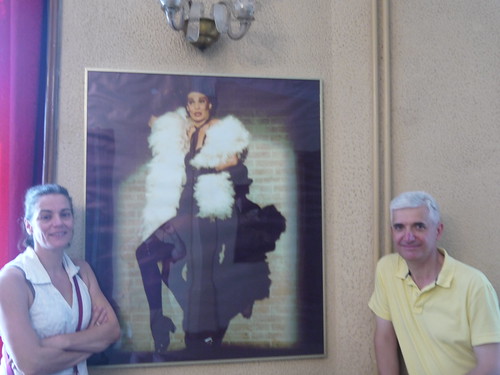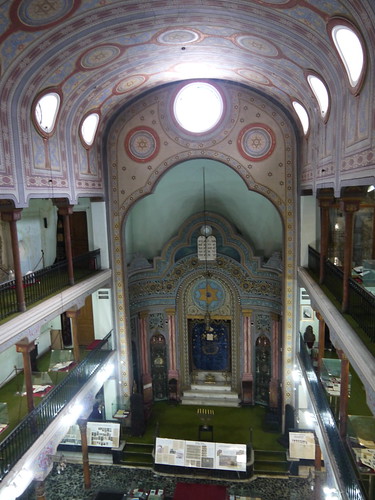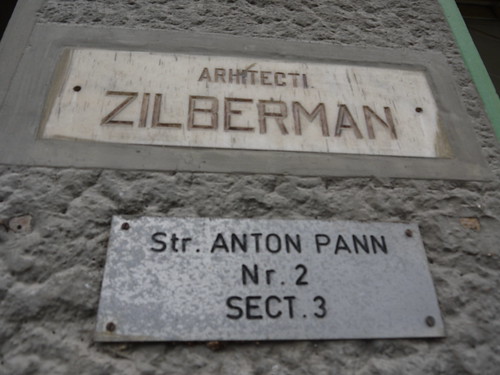Romania was once home to over 800,000 Jews. It was a thriving, vibrant community that included musicians, architects, artists, actors, tailors, cobblers, manual workers, religious and secular communities, Zionists and assimilated Jews. Up to 380,00 were killed or caused to die during the second world war when Romania was allied to the Germans and the other Axis powers. Of those that remained in Romania after the war, a further 300,000 left primarily for Israel between 1948 and 1988, but not before former President Nicolae Ceausescu had received payment from the Israeli government for every Jew he allowed to leave. Today there are about 5,000 Romanians who either identify as, or know that they are Jewish.
This ageing remnant of a once proud community is surprisingly active. It supports a museum, three working synagogues and a community centre whilst the state supports the world famous Jewish Theatre. Last weekend I was lucky enough to not only visit some of the remaining Jewish landmarks, but also to walk through the streets of the former Jewish quarter and to meet some of the remaining community members. I could not have done this without the help and guidance of Valentin Mandache, Architectural Historian, holder of many interesting stories of Bucharest and publisher of an excellent, much followed and highly recommended blog - Historic Houses of Romania.
This was my first visit to Romania. I have been to central and eastern Europe many times, but never before to Bucharest. Its not that I wasn't curious about the city once known as Little Paris, or the Paris of the East - I was. I have enjoyed the compositions of Enescu and the gypsy inspired musical tradition of Romania. I have read the diaries of Mikhail Sebastian. I have been enchanted by the romantic sounding Romanian names - Viscopoleanu, Ionesco, Popescu, Corbu and Teodorescu. When I was a child I was fascinated to know that my name - Adrian - was not unknown in Romania, indeed in the 1970's I remember a Romanian high jumper called Adrian Proteasa - who according to Wikipedia now lives and coaches in Norway!
I am not sure why its taken me so long to visit, but I suspect its because of the undeserved bleak and grim image that Bucharest has in the west. We know about the Ceausescu regime. We know about the orphans of that period and we know that a combination of earthquakes and Communist style urban planning blighted huge tracts of the city. But many (most?) people in the west don't know that Bucharest has many treasures. There are hundreds of exquisite art deco and modernist buildings from the 1920's and 1930's. There are heart stoppingly beautiful buildings in the Neo Romanian style from the early 1900's and later, there are art nouveau buildings, beautiful parks, very good restaurants, a fast developing (reviving?) cafe scene with excellent coffee and yes, you guessed it, great cakes and ice-creams, a small but good quality jazz scene (good for me!) and some remarkably friendly and accommodating people.
But back to Jewish Bucharest. Its hard to know what to include under this subject since so many famous Bucharest residents were at leads of Jewish origin. Let's start with the living. One of the unexpected highlights of my visit came on Saturday morning when Valentin took me on a tour of the remaining Marcel Janco designed buildings of the city. This was exciting enough in itself, but as we approached the State Jewish Theatre, we were greeted by a small group of people outside the building who asked if we were interested to see inside - which of course we were. Thinking we might just get a peep at the lobby I followed the male administrator in (who turned out not to be Jewish), plus an elegant woman who Valentin discretely told me was non other than Maia Morgenstern, star and now Director of the Theatre and well-known Hollywood actress. And guess what? She took us around the building herself, including a visit to the auditorium. The theatre seats about 270 people in the stalls and the circle and I had the experience of looking out at those seats from the stage. Imagine, being invited to stand on the stage of the world famous State Jewish Theatre of Bucharest in the company of its finest actress who also happened to have taken over the job of Director a few days earlier!
 |
| Maia Morgenstern, Director of the State Jewish Theatre and Valentin Mandache, architectural historical |
The theatre is much loved and cherished by the company - most of whom are not Jewish and who have to learn the Yiddish plays phonetically, being able to neither read nor or understand Yiddish! To make this even more of a challenge, each seat has built in simultaneous translation technology for the Romanian audience but the actors can sometimes hear the translation too which must be extremely off putting for them! The theatre needs investment to secure its long term future. Maia explained that her vision is for a vibrant theatre with a regular audience and that she would like to "restore" rather than "renovate" the building. This was good to hear as a number of heritage buildings have been "improved" when renovated by including plastic windows, covering up beautiful fascias or applying unattractive renderings! The theatre is one of a very few remaining venues in the world where plays are still performed in Yiddish. It is of international importance and not just to Jews, but also to theatre lovers, historians and people who care about culture and heritage. It would be good to see organisations from around the world work together with Maia and her colleagues to ensure the glittering history of the Theatre is preserved and continues.
I also met two other interesting people from the community. A young man called David, in his early twenties and working for the Jewish community in the office adjacent to the beautiful (but under restoration) Choral Temple and a very charming older lady called Hilda Grunman who I met at the Jewish Museum which is housed in the former tailor's synagogue. David wants to make aliyah (emigrate to Israel) to join some of his other family members who have already gone. He is active in the Bucharest community, working at the centre that supports older people but also taking an interest in the somewhat impressive programme for younger people which includes screenings, music events, cookery and yoga! He explained that there are a significant number of Romanian Jews who either don't want to, or are too frightened to identify as such and that the more secular activities are offered to offer a way in, or back to the community for these people.
Hilda gave us a brief tour of the museum explaining a little of the long history of Romanian Jewry, its long commitment to the country, its contribution to the First World War effort, the suffering of the Second World War years and of earlier pogroms , such as in Kishniev in 1903 as well as the many achievements in the arts, sciences and business that the Jews achieved in and for Romania. She told me she had lived in Bucharest all of her life. She had learned Hebrew as a child but hadn't spoken it in years - surprising herself at being able to answer my questions when I practised my own Hebrew! She explained that as the community is so small, many Romanian Jews "marry out" and wondered what religion her grandchildren would be in such an environment. There was not time to talk further with her but she did tell me I should come again - and I would like to!
Walking through the streets of the old Jewish quarter, I recognised the sadness of absence that permeates many cities in this part of the world that once had large Jewish communities. The appalling, irrecoverable loss is almost palpable, whilst the thought of what might have been in these cities if history had taken a different course inevitably comes to mind.
I visited three synagogues during my time in Bucharest. I have already mentioned the former taylor's synagogue, officially called the Holy Union Temple and situated on Mamulari Street. Inaugurated in 1852, it today hosts the Dr. Moses Rosen Museum of Romanian Jewish History. The museum houses a traditional exhibition of photographs, books, documents and religious artefacts on the ground floor, including a few items relating to Marcel Janco, Max Maxy, Tristan Tzara and Ilarie Voronca. I will write more about these avant-garde artists in a later post. There is also a small Holocaust exhibition which includes harrowing photographs of victims of the Iasi pogrom of June 1941. The former women's gallery houses a collection of paintings by important Romanian Jewish artists including Iosef Iser and an early work by Reuven Rubin as well as a small display of graphic design on this floor, including theatre posters and political notices from the pre World War Two years. The synagogue itself is well cared for, appears to have undergone restoration in the last few years and is decorated with Magen Dovids, geometric and floral patterns. It is a beautiful place. It is heartbreaking that its sole (albeit important) function now is as a museum and not as a centre of Jewish communal life as it would once have been. A suggestion - the museum could raise much needed funds through a publishing programme including reproductions of some of the rich collection of photographs as postcards and posters. I have no doubt overseas visitors would buy such items. I certainly would.
The Yeshua Tova synagogue in Take Ionescu Street is a much simpler affair. "Stories and Images of Jewish Bucharest" by Felicia Waldman and Anca Ciuciu says that it was built in 1840 and extended in 1890, but the interior at least looks more recent, with yeshiva style seating, enabling Torah students to face each other in debate, what appears to be a community kitchen (with the most delicious smells of aubergines being cooked drifting into the prayer hall!) and a permanent Sukkah built on to the rear of the building for communal seders.
The Choral Temple in Sf. Vineri Street was inaugurated in 1867 and is built in the Moorish style. It is one of the largest synagogues in Europe, but I was only able to see the exterior due to restoration works being underway inside. Another reason to go back to Bucharest! There is a fourth synagogue - The Great Synagogue on Vasile Adamache Street which houses the a permanent Holocaust exhibition. Built in 1847 it was modified and extended in 1903 and 1909.
Building in former Jewish quarter, designed by Jewish architect Zilberman
Religious and community buildings are only one part of the former Jewish Bucharest. Much more numerous are the wonderful 1920's and 1930's buildings designed by Jewish architects, often for members of their community and not least those of the extraordinary Marcel Janco. And that story, together with a little about the avant-garde art scene of Bucharest in this period will appear in my next post. But first a musical treat from the recently departed Israeli singer, Yafa Yarkoni, performing a somewhat theatrical version of the Yiddish song "Romania, Romania" which tells about the happy times in this fascinating country.
For more photographs of Bucharest see here
For more information about Jewish Bucharest see the excellent book Stories and Images of Jewish Bucharest by Felicia Waldman and Anca Ciuciu published by media print in 2011 ISBN 978-606-572-001-5. Not currently listed on Amazon so contact the publishers directly if you want a copy of your own.




Dear Adrian,
ReplyDeleteI was very moved by your blog about the Jews in Bucharest. Since all my jewish family have their origins in Bucharest this has for me a very special meaning. I even speak romanian and still, I have never been there, cause I was born in Germany and none of my family stayed in Romania after Ceausescu. I was always thinking to go one day and to make a journey back to my roots, but I had always this very uncomfortable feeling of doing it, especially by my own, which I would need to do if I would go. I am scared of what I would discover. Maybe also that the illusion of the stories that were told in my family would be destroyed, cause they talked mostly of the good old times, when Bucharest was called 'Little Paris'. But of course also the Antisemitsm and the times during War are in my mind and therefore to know that the jews were not anymore welcomed and maybe still aren't, doesn't make it easier for me to just go and see … But your blog somehow did something to me and I suddenly felt the urge of doing it ! Too many things seemed so familiar ... It looks like the time has finally come. I actually feel ready now and your blog proved it to me that I really want to go and see it with my own eyes and to feel and experience something profound that has so much to do with me ! The curiosity and the longing of maybe finding some answers are now finally bigger than the fear ! Thank you so much for this :) !! Funnily enough I live at the moment also in London like you :) - Just curious : What are your origins Adrian ? / It would be lovely to hear back from you and keep your passion for travelling, that is such a great thing to do :) !! Warm regards, Vicky
Hello Vicky. Thanks very much for your comments. I am touched that my post has had such an effect on you. If you want to email me at adrianwhittle@hotmail.com I will be very happy to pass you further details. I am visiting family in Australia at the moment and dependant on cafe wi-fi, so forgive me if it takes a little time to reply. Very best wishes. Adrian.
DeleteHello Adrian and Vicky,
ReplyDeleteMy fam and I got out of Romania January 3rd 1965. Not a day too soon. I am happy to be in America (Los Angeles) for the past 49 years.
I went back to Bucharest (I was born there) several times. I went back to see my school friends. Bucharest is a disaster. Awful! The Temples are not being maintained and Jewish life (not that it was a lot in 1947-1965) is minimal. The majority of Jews left Bucharest and for that matter Romania. As I read somewhere, there are a couple of thousand Jews left in the whole country. I went to the Jewish cemetery in Bucharest a few years ago. Abandoned! At least it looked that way. In my opinion, the Jewish life in Romania is non existent. Too bad!.
Hello and thanks very much for your comments. It is sad that Jewish life has all but ceased in Romania with so few people remaining there now. Best wishes.
DeleteThanks.
ReplyDeleteI am impressed on your articles that signify total Romania culture.I would like to take a tour in Romania .
ReplyDelete